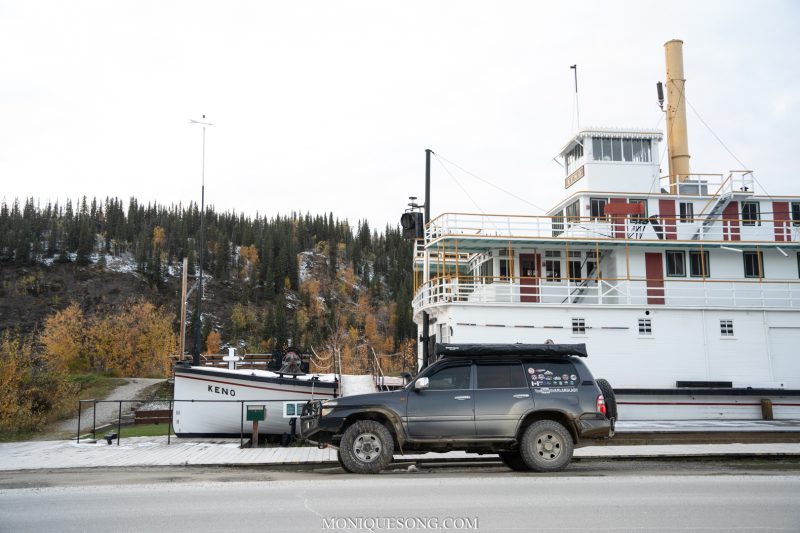
It’s essential that you travel in comfort when exploring the world. My Landcruiser is set up to comfortably travel the land as a single person. You can see my modification list here. There’s always a debate in the emerging “overlanding” community. The chase for better, more expensive gear promotes industry growth. But the high ticket price and the overwhelming list of gear can also discourage some newcomers.
As I said, my cruiser was built to sleep one. When I picked up my friend from Whitehorse during my Arctic trip, we had to resort to booking hotels for lodging.
Since losing Altar, I’ve been taking baby steps getting my feet wet in the camping water again. All with simple camping gear: a ground tent, sleeping bag, backpacking stoves, etc.
You don’t need all the fancy gear to get out there. In fact, the gear you need can sometimes get in the way. So, here are some practical tips for finding a good balance.
Quality Footwear is Essential
First and foremost, your footwear is absolutely vital. The wrong shoes will result in extra weight, sores, and blisters. But it can also cause temperature-related issues such as fungal infections in heat and frostbite in the cold. Therefore it helps to pack the various types you will need while in another country. For example, you don’t need heavy-duty hiking boots when exploring a hillside area. And sports companies like Nike now produce considerably comfy shoes with memory foam insoles, adequate protection from stones and uneven terrain, and breathable materials.
Get a Backpack for Comfort when Exploring
Your backpack is an essential piece of gear when going out at any time. Backpacks range from small carriers for day trips to camping and survival models. Large backpacks come with everything you need to secure essential gear. Yet cheaper ones aren’t comfortable. And even quality models can be bulky. So, like your shoes, consider the type of backpack you need for your trip. For example, there’s no need for your camping model for a short hike to a hillside castle. But always get the most comfortable straps that can take the weight off your shoulders.
Share the Burden
Taking a trip alone is a great way to find yourself and do what you need to relax. But taking a trip with friends and family is also one of the best ways to connect and bond. And being with others also means you can equally share the responsibility of carrying essentials. For instance, it isn’t fair for you to be carrying an encumbered backpack alone. You will tire quickly and possibly get hurt. Therefore, share the weight of any supplies among your party according to what each person can reasonably carry. And always stop for rest should anyone require it.
Buy Lighter Versions of Your Gear
When you buy your exploration gear, it’s typical to buy heavy models because it implies quality and reliability. First, this isn’t always the case. And second, you need to consider the weight of individual items. If you have weight trouble, buy lighter models of your equipment, such as:
- Consider swapping your camera tech models.
- Use pop-up tents that don’t require poles or lightweight poles.
- Only use heavy-duty hiking boots when necessary.
- Consider your sleeping bag and pad needs.
- Take a suitable, lighter backpack for shorter journeys.
A light camera doesn’t mean poor quality. For example, the Canon EOS range offers several lightweights, high-quality DSLRs. Our smartphones take astonishing photos nowadays.
When travelling in my car, I use an ARB sleeping bag. It has a canvas out shell with a fleece liner, much like the home blanket feel. But it is very bulky. For lightweight camping, I resort to a dawn sleeping bag with a low-temperature rating.
Consider Essentials Against Luxuries
Depending on how far you plan to venture out, you will need different equipment. Yet it’s common for hikers, especially beginners, to prioritize luxuries over needs. Common examples include cosmetic items, games, and ice boxes. None of these are required when camping. And they just add unnecessary weight to your overall carry. Instead, you will need your strength and bag room to carry genuine essentials such as lighting, batteries, food, and water. And that’s in addition to your already heavy sleeping bags, tent, and cooking equipment.
Comfort when Exploring Means Knowing Your Limit
You might want to carry as much as possible to make your life easier when you get there. But people often underestimate the journey. Even a three-mile trip with a backpack can be extremely uncomfortable when you have to deal with temperatures, varying inclines, and uneasy terrain. In short, it can feel like double the work and twice the distance. So you need to know your limits. And this includes how much you can comfortably carry and the distance you can walk. Most experts agree you carry no more than 20% of your body weight or 30 lbs.
Never Venture Too Far (until you’re ready for it)
Venturing out can be very dangerous, especially for the inexperienced. Therefore, you mustn’t go too far until you have years of experience under your belt. Carrying stuff to your chosen destination is all well and good. But remember, you also need to bring it back. And the golden rule of camping is to leave the site better than you found it. So assuming everything goes OK, you still need water and food for the return journey, as well as your gear. Additionally, you need to stay in the range of emergency services should something go wrong.
Summary
You need your comfort when exploring. But it can be challenging to strike the right balance. You can help with suitable footwear, lighter gear, and sticking within a reasonable distance.
